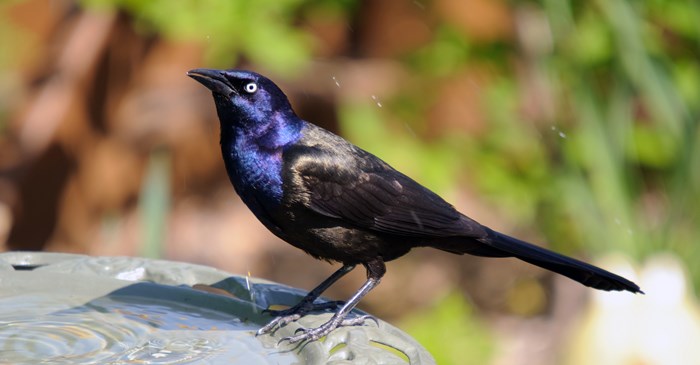Many birds get their color from pigments, but some of our winged visitors have more surprising stories behind the colors of their feathers.
Shiny feathers
Ever notice how some birds seem to glisten and shine? Think of a peacock with his gem-colored fan. These are iridescent feathers. In your back yard, a purple martin might be one of the jeweled visitors that lands on your feeder. Even if you look closely at more common, less-desired bird visitors, such as European starlings and grackles, their dark-colored feathers also glisten.
How do these birds get their shine? It’s a bit of an abstract concept, but it has to do with the structure of the feather and how light interacts with it. Much like a prism, these feather structures refract light, splitting it into colors.
Blue feathers
You will not find a trace of blue pigment in the feathers of a blue bird or blue jay. Again, it’s how we see it. Seeing the blue has everything to do with feather structure and how light bounces off that to create a vision in blue. In this case, however, we don’t experience the iridescent effect, so unlike the peacock, these feathers don’t gleam and shine.
Red, yellow and orange feathers
Some red, yellow or orange birds earn their plumages from their diet. Flowers, seeds, roots and fruits provide carotenoids to transform their feathers into these bright colors. Cardinals get their red feathers from the berries of dogwood tree, along with many types of seeds. Goldfinches become yellow exclusively due to the seed they eat.
Black wingtips
Look closer at the bird. Does it have black wingtips? These black wingtips are quite common, even in all-white birds. They make up the bird’s flight feathers, which see a lot of wear and tear. The black does come from pigment, but the purpose of the pigment is quite surprising. The extra melanin that makes them black also gives the feather extra strength!
To attract red cardinals to your feeder, try Lyric Cardinal Premium Sunflower and Safflower Wild Bird Mix. To draw colorful finches, try Lyric Nyjer Seed.
